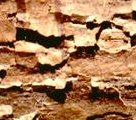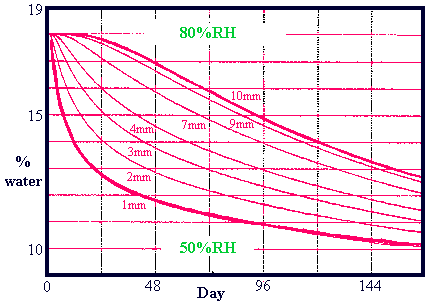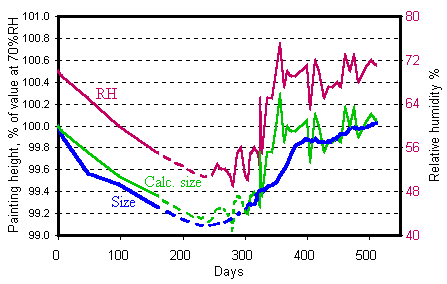
 |
The rate at which wood responds to moist air |
 The rate of water desorption by a panel, such as the altar picture described earlier, can be modelled. The diagram shows the water content at different depths from the surface of a wooden panel which is 10mm thick and impermeable on one side. The panel has first been brought to equilibrium with 80% RH. The diagram begins when the panel is suddenly placed in quiet air (1m/s) at 50%RH.
The rate of water desorption by a panel, such as the altar picture described earlier, can be modelled. The diagram shows the water content at different depths from the surface of a wooden panel which is 10mm thick and impermeable on one side. The panel has first been brought to equilibrium with 80% RH. The diagram begins when the panel is suddenly placed in quiet air (1m/s) at 50%RH.
It takes about fifty days for the plank to come half way to equilibrium at the lower RH.
 The diagram above gives no indication of the shrinkage of the plank as a whole. A further elaborate calculation would be needed to determine the size of a plank with a water content that varies with depth. At some point it becomes less interesting to play with abstract equations and more rewarding to measure the object itself.
The diagram above gives no indication of the shrinkage of the plank as a whole. A further elaborate calculation would be needed to determine the size of a plank with a water content that varies with depth. At some point it becomes less interesting to play with abstract equations and more rewarding to measure the object itself.
The large horizontal crack between the planks of the altar picture (see the previous section) gave us a chance to measure the reaction of the picture to changing RH. The picture was jammed in its frame at top and bottom, so that the gap opened and closed according to the ambient conditions.
The green line is the size calculated on the assumption of instant equilibration of the 10mm thick panel to the ambient RH. At first, during the slow drying of the picture the theoretical and measured sizes follow each other closely. Then the picture was rehumidified, to stop the flaking and to allow conservation in similar conditions to those of the church where it would be displayed. Notice the approximately 50 day delay in attaining equilibrium after the RH was suddenly raised, on day 330. It is, no doubt, a pleasing coincidence that theory and practice are in such good agreement
Rapid RH change can also causes internal stresses in massive wood with no surface coating. As the graphs show, the penetration of water into wood as the surrounding RH changes is a fairly leisurely affair. Large transient stresses can build up when the outer skin tries to change size against an inner core that has not yet noticed that the RH has changed.
 These stresses can be large enough to destroy the internal structure of the wood. The compressive strength of wood in the transverse (radial or tangential) directions is quite low: about 8MPa. The limit for elastic deformation is about 1.6% compression. This is the dimensional change that corresponds to a change from 40% to 70%RH. A sudden increase in ambient RH will cause the surface layer of wood to try to expand. But it is restrained by the still dry inner core of the plank. This invisible stress will cause irreversible collapse of the cellular structure of the wood at the surface. When the plank eventually reaches equilibrium, the outer layer will be shorter, and in tension. This causes a bend in the plank, even though the water content is now uniform throughout the thickness.
These stresses can be large enough to destroy the internal structure of the wood. The compressive strength of wood in the transverse (radial or tangential) directions is quite low: about 8MPa. The limit for elastic deformation is about 1.6% compression. This is the dimensional change that corresponds to a change from 40% to 70%RH. A sudden increase in ambient RH will cause the surface layer of wood to try to expand. But it is restrained by the still dry inner core of the plank. This invisible stress will cause irreversible collapse of the cellular structure of the wood at the surface. When the plank eventually reaches equilibrium, the outer layer will be shorter, and in tension. This causes a bend in the plank, even though the water content is now uniform throughout the thickness.
Mrs Eliza Esterbrook, now a permanent resident in the basement of the Museum of American History in Washington D.C., has grown stouter with the years. The raking light from the right reveals the bowing out of the panel, caused by repeated absorption and desorption of water on the unprotected back. The mirror placed above the portrait shows the view looking down on the top edge of the panel. Eliza's husband had a coat of paint on the back of his portrait. He is as straight and slim as ever.
A more dramatic example of this phenomenon is described in the chapter "Bending the evidence".
The work on the Gierslev altar picture (Sealand, Denmark), described in this chapter, was done in collaboration with Stephanie Noerbel, a conservator of polychrome sculpture at the Conservation Department of the National Museum of Denmark

This work is licensed under a Creative Commons Attribution-Noncommercial-No Derivative Works 3.0 License.